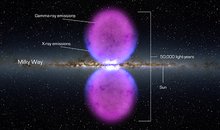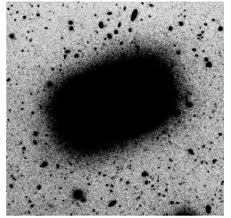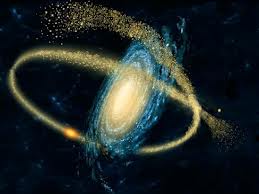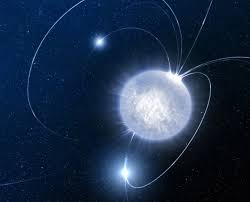- Fermi Bubbles

The bubbles are massive, mysterious structures that emanate from the Milky Way’s center and extend roughly 20000 light years above and below the galactic plane. The strange phenomenon was first discovered in 2010 and it is made up of super high energy gamma and x ray emissions which is invisible to human eyes. Scientists have guessed that the gamma rays might be shock waves from stars being consumed by the massive black hole at the center of the galaxy.
2. The Rectangular galaxy
Earlier this year, scientists have spotted a celestial body, roughly 70 million light years away with an appearance that is unique in the visible universe : The galaxy LEDA 074886 is shaped more or less like a rectangle. While other galaxies are shaped like discs, three-dimensional eclipses or irregular blobs, this one seems to have a regular rectangle shaped appearance.
- What Re-ionized the Universe?
Big Bang is broadly accepted model for the origin of the universe state that cosmos began as a hot, dense point approximately 13.7 billion years ago. The early universe is believed to have been a dynamic place and about 13 billion years ago, it underwent a so-called age of re-ionization. The universe
that cosmos began as a hot, dense point approximately 13.7 billion years ago. The early universe is believed to have been a dynamic place and about 13 billion years ago, it underwent a so-called age of re-ionization. The universe
Some fog of hydrogen gas was clearing and becoming translucent to ultraviolet light fir the first time. Scientists are puzzled over what caused this re-ionization to occur.
- What’s the source of the Most Energetic Cosmic Rays?
Cosmic rays are highly energetic particles that flow into our solar s ystem from deep in outer space, but the actual origin has been puzzling astronomers for about a century. The cosmic rays are as much strong as 100 million times the particles that have been produced in manmade colliders.
ystem from deep in outer space, but the actual origin has been puzzling astronomers for about a century. The cosmic rays are as much strong as 100 million times the particles that have been produced in manmade colliders.
- Galactic Recycling
Astronomers have noticed that galaxies form new stars at a rate that would consume more matter than they actually have inside them. The Milky Way for example appears to turn one sun’s worth of dust and gas into new stars every year, but it doesn’t have enough spare matter to keep this up long term. Astronomers noticed gas that had been expelle d by the galaxies flowing back in to the center. If the galaxies recycle this gas to produce new stars, it might be a piece of the puzzle in solving the question of the missing raw matter.
d by the galaxies flowing back in to the center. If the galaxies recycle this gas to produce new stars, it might be a piece of the puzzle in solving the question of the missing raw matter.
